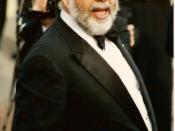In Francis Ford Coppola's "Apocalypse Now," a band of soldiers take their helicopters over a small Vietnamese village, and the blaring tones of Wagner's musical piece "Ride of the Valkyries" comes on. In short, Coppola's objective was to associate Wagner's connection with the Nazis and America's unjust involvement in the Vietnam War. Wagner was truly one of the great composers, but his ties and support of the Nazis truly stained his career as we look back upon him, and his music is associated with the Nazis, none more so than "Ride of the Valkyries," which, with its harsh, moving tones, conjures the image of a meticulous army marching in sync. Clearly, Coppola is trying to convey that America, in launching these attacks on Vietnam, is being imperialistic and overly nationalistic, as the bravado and hubris is truly overblown by Wagner's piece.
Antonin Dvorak's "Symphony from a New World" would fit very well Edwark Zwick's film "The Last Samurai."
Captain Nathan Algren, an American, is sent to Japan to train troops, but it later captured by samurai. He is living with a family that cannot speak his language, and he is truly lost. He is confused, and longs for a means of escape. Eventually however, he falls in love with the culture and also befriends his host, Taka, the young Japanese wife of a man Algren killed. In the end, they see each other as very close, and Algren fills the role of the father. However, one day, Algren must leave, along with samurai, to battle the troops he had partially trained. He is not killed and is separated from the village for several months However, in a beautiful scene at the end, Algren returns to the village, and he and Taka see each other once again. In this scene...


